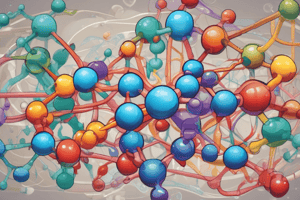Podcast
Questions and Answers
Which molecule is considered organic based on the information provided?
Which molecule is considered organic based on the information provided?
- NaCl
- CO2
- H2O
- CH4 (correct)
What kind of chemical bond is involved when electrons are being shared between atoms?
What kind of chemical bond is involved when electrons are being shared between atoms?
- Ionic bond
- Hydrogen bond
- Van der Waals forces
- Covalent bond (correct)
Which of the following is NOT a characteristic of organic molecules?
Which of the following is NOT a characteristic of organic molecules?
- They are always large and complex. (correct)
- They can include other elements like nitrogen and oxygen.
- They can contain hydrogen atoms.
- They contain carbon atoms.
What is the defining characteristic of a macromolecule?
What is the defining characteristic of a macromolecule?
Which of the following molecules is a polymer?
Which of the following molecules is a polymer?
Which macromolecule group is NOT composed of repeating monomer units?
Which macromolecule group is NOT composed of repeating monomer units?
What is the monomer unit that makes up a protein?
What is the monomer unit that makes up a protein?
Which of the following is an example of a carbohydrate?
Which of the following is an example of a carbohydrate?
Where are DNA molecules located in a cell?
Where are DNA molecules located in a cell?
Flashcards
Organic Molecules
Organic Molecules
Molecules containing carbon and hydrogen, often with nitrogen, oxygen, phosphorus, or sulfur.
Carbon
Carbon
Element with four valence electrons, allowing it to bond with various atoms.
Macromolecule
Macromolecule
Large, complex molecules made of repeating smaller units called monomers.
Monomer
Monomer
Signup and view all the flashcards
Carbohydrates
Carbohydrates
Signup and view all the flashcards
Lipids
Lipids
Signup and view all the flashcards
Proteins
Proteins
Signup and view all the flashcards
Nucleic Acids
Nucleic Acids
Signup and view all the flashcards
Polysaccharide
Polysaccharide
Signup and view all the flashcards
Study Notes
Organic Molecules
- Organic molecules contain carbon bonded to other carbon atoms and hydrogen.
- They often include nitrogen, oxygen, phosphorus, and/or sulfur.
- Examples of organic molecules include C₆H₁₂O₆ (glucose) and CH₄ (methane).
- Examples of inorganic molecules include H₂O (water) and CO₂ (carbon dioxide).
Carbon
- Carbon's four valence electrons allow it to form bonds with other carbon atoms and with hydrogen, nitrogen, and oxygen.
- These bonds are covalent, meaning electrons are shared.
Macromolecules
- Macromolecules are large, complex molecules built from repeating smaller units (monomers).
Four Main Types of Biological Macromolecules
-
Carbohydrates: Formed from monosaccharides
-
Lipids: Do not follow the pattern of repeating monomers.
-
Proteins: Formed from amino acids
-
Nucleic Acids: Formed from nucleotides (e.g., DNA). DNA is found in chromosomes.
-
Polymers of carbohydrates are polysaccharides (e.g., starch).
Studying That Suits You
Use AI to generate personalized quizzes and flashcards to suit your learning preferences.




